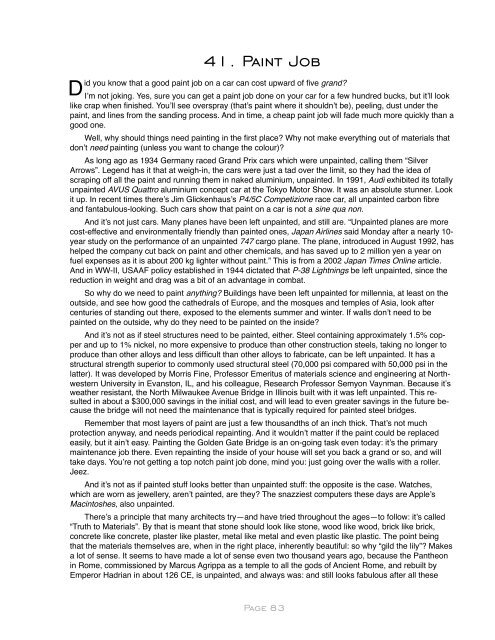Common Sense 101 - Engineering - December 16, 2012 Edition
You also want an ePaper? Increase the reach of your titles
YUMPU automatically turns print PDFs into web optimized ePapers that Google loves.
D<br />
41. Paint Job<br />
id you know that a good paint job on a car can cost upward of five grand?<br />
I’m not joking. Yes, sure you can get a paint job done on your car for a few hundred bucks, but it’ll look<br />
like crap when finished. You’ll see overspray (that’s paint where it shouldn’t be), peeling, dust under the<br />
paint, and lines from the sanding process. And in time, a cheap paint job will fade much more quickly than a<br />
good one.<br />
Well, why should things need painting in the first place? Why not make everything out of materials that<br />
don’t need painting (unless you want to change the colour)?<br />
As long ago as 1934 Germany raced Grand Prix cars which were unpainted, calling them “Silver<br />
Arrows”. Legend has it that at weigh-in, the cars were just a tad over the limit, so they had the idea of<br />
scraping off all the paint and running them in naked aluminium, unpainted. In 1991, Audi exhibited its totally<br />
unpainted AVUS Quattro aluminium concept car at the Tokyo Motor Show. It was an absolute stunner. Look<br />
it up. In recent times there’s Jim Glickenhaus’s P4/5C Competizione race car, all unpainted carbon fibre<br />
and fantabulous-looking. Such cars show that paint on a car is not a sine qua non.<br />
And it’s not just cars. Many planes have been left unpainted, and still are. “Unpainted planes are more<br />
cost-effective and environmentally friendly than painted ones, Japan Airlines said Monday after a nearly 10year<br />
study on the performance of an unpainted 747 cargo plane. The plane, introduced in August 1992, has<br />
helped the company cut back on paint and other chemicals, and has saved up to 2 million yen a year on<br />
fuel expenses as it is about 200 kg lighter without paint.” This is from a 2002 Japan Times Online article.<br />
And in WW-II, USAAF policy established in 1944 dictated that P-38 Lightnings be left unpainted, since the<br />
reduction in weight and drag was a bit of an advantage in combat.<br />
So why do we need to paint anything? Buildings have been left unpainted for millennia, at least on the<br />
outside, and see how good the cathedrals of Europe, and the mosques and temples of Asia, look after<br />
centuries of standing out there, exposed to the elements summer and winter. If walls don’t need to be<br />
painted on the outside, why do they need to be painted on the inside?<br />
And it’s not as if steel structures need to be painted, either. Steel containing approximately 1.5% copper<br />
and up to 1% nickel, no more expensive to produce than other construction steels, taking no longer to<br />
produce than other alloys and less difficult than other alloys to fabricate, can be left unpainted. It has a<br />
structural strength superior to commonly used structural steel (70,000 psi compared with 50,000 psi in the<br />
latter). It was developed by Morris Fine, Professor Emeritus of materials science and engineering at Northwestern<br />
University in Evanston, IL, and his colleague, Research Professor Semyon Vaynman. Because it’s<br />
weather resistant, the North Milwaukee Avenue Bridge in Illinois built with it was left unpainted. This resulted<br />
in about a $300,000 savings in the initial cost, and will lead to even greater savings in the future because<br />
the bridge will not need the maintenance that is typically required for painted steel bridges.<br />
Remember that most layers of paint are just a few thousandths of an inch thick. That’s not much<br />
protection anyway, and needs periodical repainting. And it wouldn’t matter if the paint could be replaced<br />
easily, but it ain’t easy. Painting the Golden Gate Bridge is an on-going task even today: it’s the primary<br />
maintenance job there. Even repainting the inside of your house will set you back a grand or so, and will<br />
take days. You’re not getting a top notch paint job done, mind you: just going over the walls with a roller.<br />
Jeez.<br />
And it’s not as if painted stuff looks better than unpainted stuff: the opposite is the case. Watches,<br />
which are worn as jewellery, aren’t painted, are they? The snazziest computers these days are Apple’s<br />
Macintoshes, also unpainted.<br />
There’s a principle that many architects try—and have tried throughout the ages—to follow: it’s called<br />
“Truth to Materials”. By that is meant that stone should look like stone, wood like wood, brick like brick,<br />
concrete like concrete, plaster like plaster, metal like metal and even plastic like plastic. The point being<br />
that the materials themselves are, when in the right place, inherently beautiful: so why “gild the lily”? Makes<br />
a lot of sense. It seems to have made a lot of sense even two thousand years ago, because the Pantheon<br />
in Rome, commissioned by Marcus Agrippa as a temple to all the gods of Ancient Rome, and rebuilt by<br />
Emperor Hadrian in about 126 CE, is unpainted, and always was: and still looks fabulous after all these<br />
Page 83



